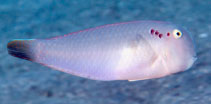| Family: |
Labridae (Wrasses), subfamily: Xyrichtyinae |
| Max. size: |
25 cm TL (male/unsexed) |
| Environment: |
reef-associated; marine; depth range 2 - 30 m |
| Distribution: |
Indo-Pacific: Red Sea and East Africa to the Pacific. |
| Diagnosis: |
Dorsal spines (total): 9-9; Dorsal soft rays (total): 12-12; Anal spines: 3-3; Anal soft rays: 12-13 |
| Biology: |
Found over sandy bottoms of coastal areas and also in areas with some seagrass or algae. Ranges to a depth of over 18 m (Ref. 9710). Usually in large spread-out groups on upper slopes of sand and mud banks with males defending its section that has numerous females (Ref. 48636). Dives into sand to sleep safely at night or to hide when alarmed (Ref. 90102). When threatened, it dives head-first into sand; may take some time to emerge again. Feeds mainly on hard-shelled prey, including mollusks and crustaceans (Ref. 5374). Minimum depth taken from Ref. 9710. |
| IUCN Red List Status: |
Least Concern (LC); Date assessed: 25 March 2009 Ref. (130435)
|
| Threat to humans: |
harmless |
Source and more info: www.fishbase.org. For personal, classroom, and other internal use only. Not for publication.

